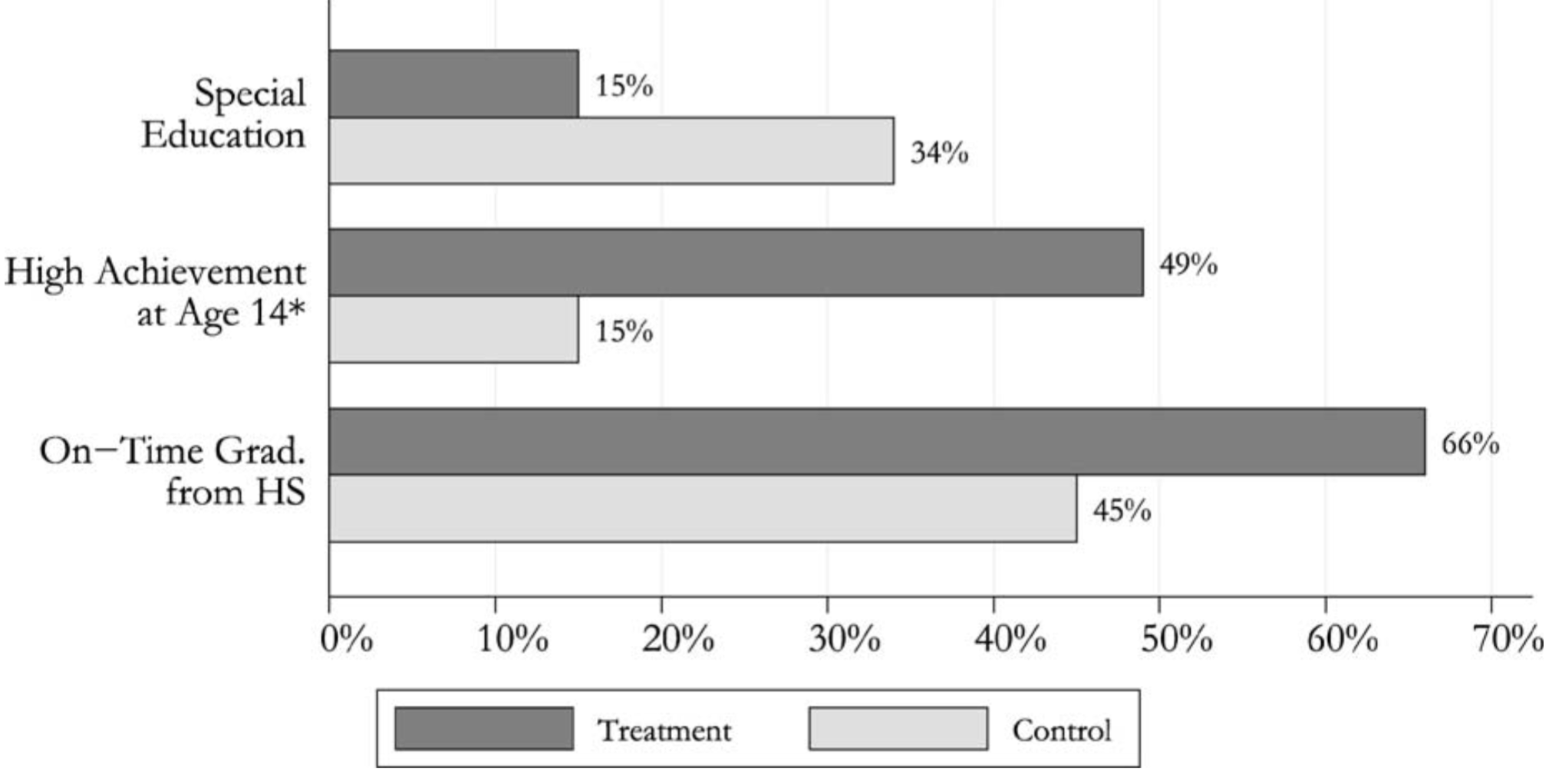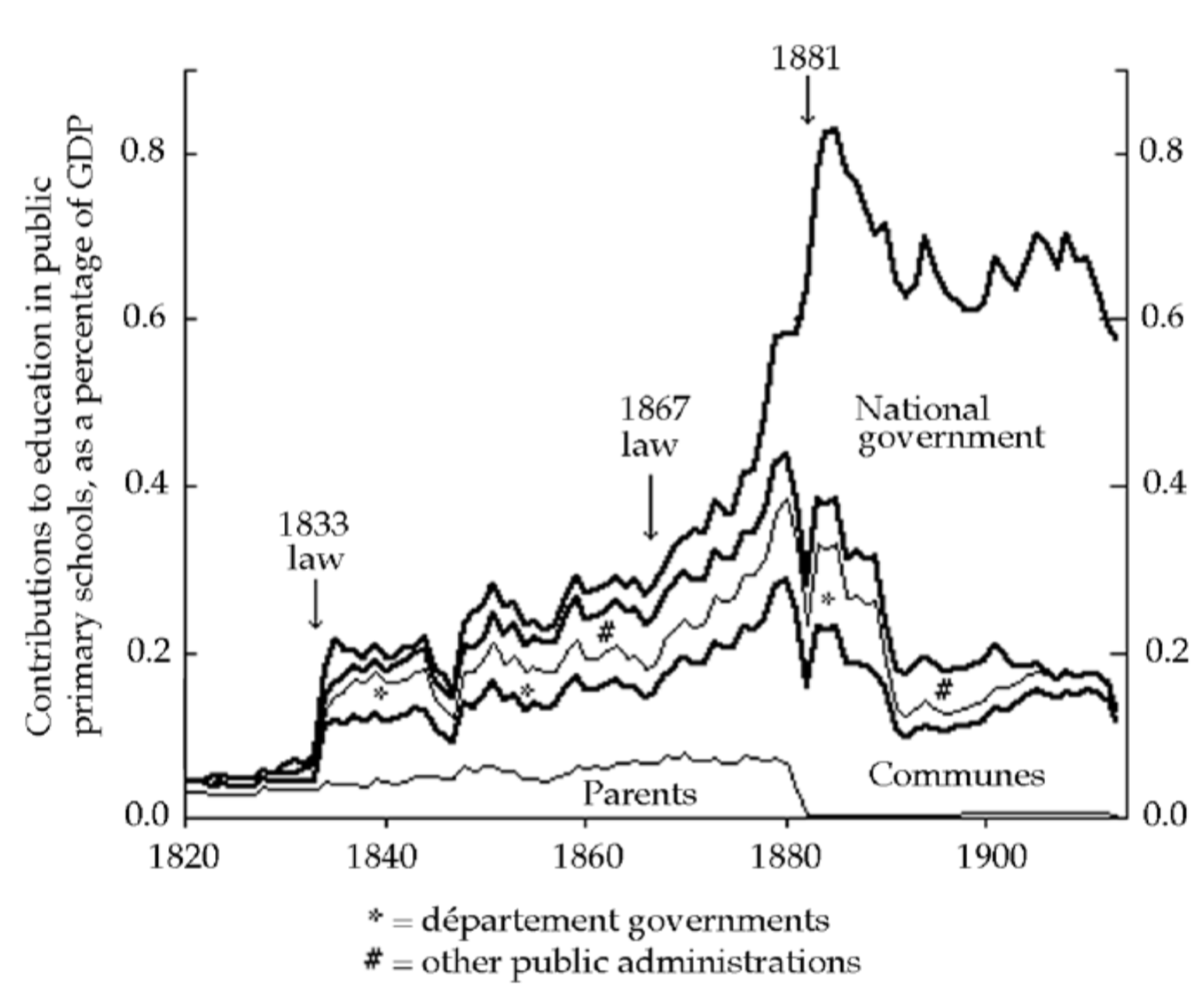
In most countries basic education is nowadays perceived not only as a right, but also as a duty – governments are typically expected to ensure access to basic education, while citizens are often required by law to attain education up to a certain basic level. 1
This was not always the case: the advancement of these ideas began in the mid-19th century, when most of today’s industrialized countries started expanding primary education, mainly through public finances and government intervention. Data from this early period shows that government funds to finance the expansion of education came from a number of different sources, but taxes at the local level played a crucial role. The historical role of local funding for public schools is important to help us understand changes – or persistence – in regional inequalities.
The second half of the 20th century marked the beginning of education expansion as a global phenomenon. Available data shows that by 1990 government spending on education as a share of national income in many developing countries was already close to the average observed in developed countries. 2
This global education expansion in the 20th century resulted in a historical reduction in education inequality across the globe: in the period 1960-2010 education inequality went down every year, for all age groups and in all world regions. Recent estimates of education inequality across age groups suggest that further reductions in schooling inequality are still to be expected within developing countries. 3
Recent cross-country data from UNESCO tells us that the world is expanding government funding for education today, and these additional public funds for education are not necessarily at the expense of other government sectors. Yet behind these broad global trends, there is substantial cross-country – and cross-regional – heterogeneity. In high-income countries, for instance, households shoulder a larger share of education expenditures at higher education levels than at lower levels – but in low-income countries, this is not the case.
Following the agreement of the Millennium Development Goals, the first decade of the 21st century saw an important increase in international financial flows under the umbrella of development assistance. Recent estimates show that development assistance for education has stopped growing since 2010, with notable aggregate reductions in flows going to primary education. These changes in the prioritization of development assistance for education across levels and regions can have potentially large distributional effects, particularly within low-income countries that depend substantially on this source of funding for basic education. 4
When analyzing correlates, determinants and consequences of education consumption, the macro data indicates that national expenditure on education does not explain well cross-country differences in learning outcomes. This suggests that for any given level of expenditure, the output achieved depends crucially on the mix of many inputs.
Available evidence specifically on the importance of school inputs to produce education, suggests that learning outcomes may be more sensitive to improvements in the quality of teachers, than to improvements in class sizes. Regarding household inputs, the recent experimental evidence suggests that interventions that increase the benefits of attending school (e.g. conditional cash transfers) are particularly likely to increase student time in school; and that those that incentivize academic effort (e.g. scholarships) are likely to improve learning outcomes.
Policy experiments have also shown that preschool investment in demand-side inputs leads to large positive impacts on education – and other important outcomes later in life. The environment that children are exposed to early in life, plays a crucial role in shaping their abilities, behavior, and talents.
Governments around the world are nowadays widely perceived to be responsible for ensuring the provision of accessible quality education. This is a recent social achievement. The advancement of the idea to provide education for more and more children only began in the mid-19th century, when most of today’s industrialized countries started expanding primary education.
The following visualization, plotting public expenditure on education as a share of Gross Domestic Product (GDP) for a number of early-industrialized countries, shows that this expansion took place mainly through public funding. Our topic page on global education provides details regarding how this expansion in funding materialized in better education outcomes for these countries.
Public schools in the US educate more than 90% of all children enrolled in elementary and secondary schools. 5
This is the result of a process of education expansion that relied heavily on public funding, particularly from local governments. The visualization shows the sources of revenues for public schools in the US over the last 120 years.
As can be seen, states and localities are – and have always been – the main sources of funding for public primary education in the US. In fact, we observe three broad periods in this graph: there is first a period of stable revenues until 1920, then a period of sharp growth and decline during the interwar years, and then a period of substantial growth since the Second World War, slowing down in the 1970s. In all these periods, federal funding was always very small.
Disaggregated data from the last couple of decades gives further insights into the specific sources of local revenues for schools in the US: the largest part comes from property taxes (about 80% of local revenues came from property taxes in 2013), while only a very small part comes from fees and donations (private funding for public schools, which is considered a local revenue, amounted to less than 2% of total public school revenues in 2013). This heavily decentralized system relying on property taxes has the potential to create large inequalities in education since public schools in affluent urban areas are able to raise more funding from local revenues. Indeed, a significant part of the debate on education inequalities in the US today focuses on the importance of increasing progressive federal spending to reduce inequalities in public school funding. 6
The case of the US above shows that funding for public schools has been historically a responsibility of local governments. In other countries, such as France, the expansion of public education also took place initially with resources from local governments, but relatively quickly the fiscal burden was shifted to the national level. In France, this transition was associated with a sharp jump towards universal access and a concomitant reduction in regional inequalities.
The following visualization from Lindert (2004) 7 provides evidence of the French experience. As we can see there are three distinct periods: education spending was initially low and mainly private, then in 1833 funding began growing with local resources after the introduction of a law liberating communes to raise more local taxes for schools, and finally in 1881 the national government took over most of the financial responsibility after the introduction of a new law that abolished all fees and tuition charges in public elementary schools. In the source book, Lindert (2004) provides further evidence of how this transition towards centrally funded public education reduced north-south inequalities in France.

A comparison of expenditure between public and private education institutions is helpful to contextualize the role the public sector played in the process of education expansion in industrialized countries. The following graph does this using data from the National Center for Education Statistics in the US.
It shows that during the years 1950-1970 – a period of substantial growth in education expenditure in the US – expenditure grew specifically in the public sector. 9
The second half of the 20th century marked the beginning of education expansion as a global phenomenon. The visualization shows government expenditure on education as a share of national income for a selection of low and middle-income countries, together with the corresponding average for high-income countries, for more than the last half-century. As can be seen, spending on education in many developing countries has become similar to the average observed in developed countries in recent decades.
It is important to point out that the remark above makes reference to convergence in expenditure relative to income . To the extent that low-income countries remain poorer than high-income countries, gaps in levels of expenditure per pupil are persistently large. Indeed, cross-country heterogeneity in education expenditure per pupil is currently much higher than heterogeneity in expenditure as a share of GDP. 10 One factor contributing to the slower convergence of expenditure per pupil in real terms is the fact that teachers' salaries – the main component of education expenditure, as discussed below – are much higher in high-income countries because labor has a higher opportunity cost in these countries. In general, the opportunity cost of labor is a key variable that governments in developing countries should factor in when deciding whether to expand education now, rather than later.
An important consequence of the global education expansion is a reduction in education inequality across the globe. The following visualization shows this through a series of graphs plotting changes in the Gini coefficient of the distribution of years of schooling across different world regions. The Gini coefficient is a measure of inequality and higher values indicate higher inequality – you can read about the definition and estimation of Gini coefficients in our related article . The time-series chart shows inequality by age group.
It can be seen that as inequality is falling over time, the level of inequality is higher for older generations than it is for younger generations. We can also see that in the reference period education inequality went down every year, for all age groups and in all world regions.
Have gains from historical education expansion fully materialized? The breakdown by age gives us a view into the future: as inequality is lower among today's younger generations, we can expect the decline of inequality to continue in the future. Thus, further reductions in education inequality are still to be expected within developing countries; and if the expansion of global education can be continued, we can speed up this important process of global convergence.
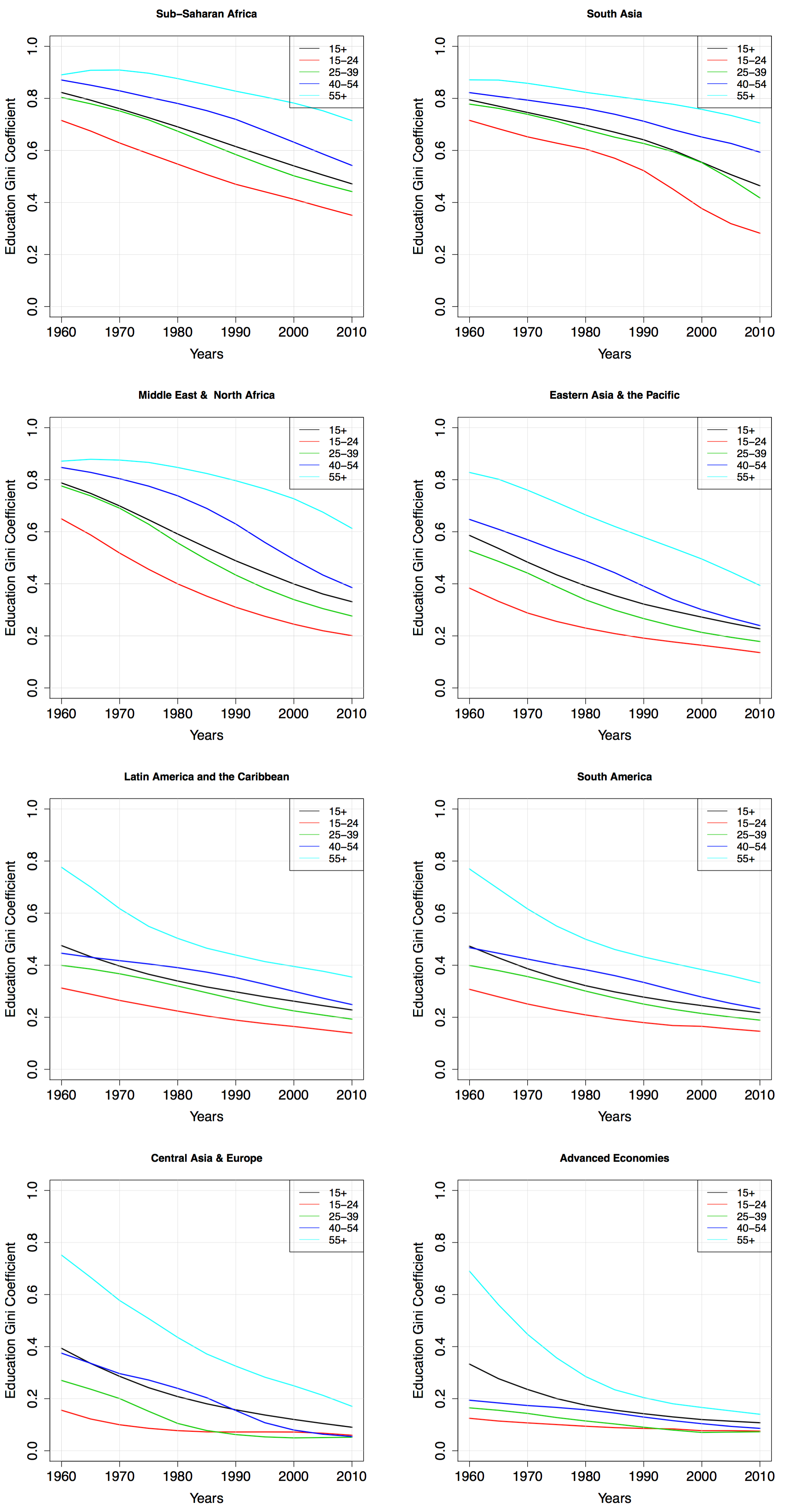
The experience of South Korea shows that it is possible to reduce education inequality rapidly across all levels of education.
The following visualization shows two graphs comparing the concentration of years of education in South Korea between the years 1970 and 2010. To be precise, each of these graphs shows an education Lorenz curve: a plot showing the cumulative percentage of the schooling years across all levels of education on the vertical axis, and the cumulative percentage of the population on the horizontal axis.
As can be seen, in 2010 education was much less concentrated than in 1970, not only because there was a smaller share of individuals without schooling (shown at the bottom of the chart), but also because there was a smaller share of individuals concentrating large proportions of school-years at higher levels of education. Indeed, in only 40 years South Korea was able to double the mean years of schooling (from 6 to 12 years) and at the same time get remarkably close to the 45-degree line marking the hypothetical scenario of perfect equality of schooling.
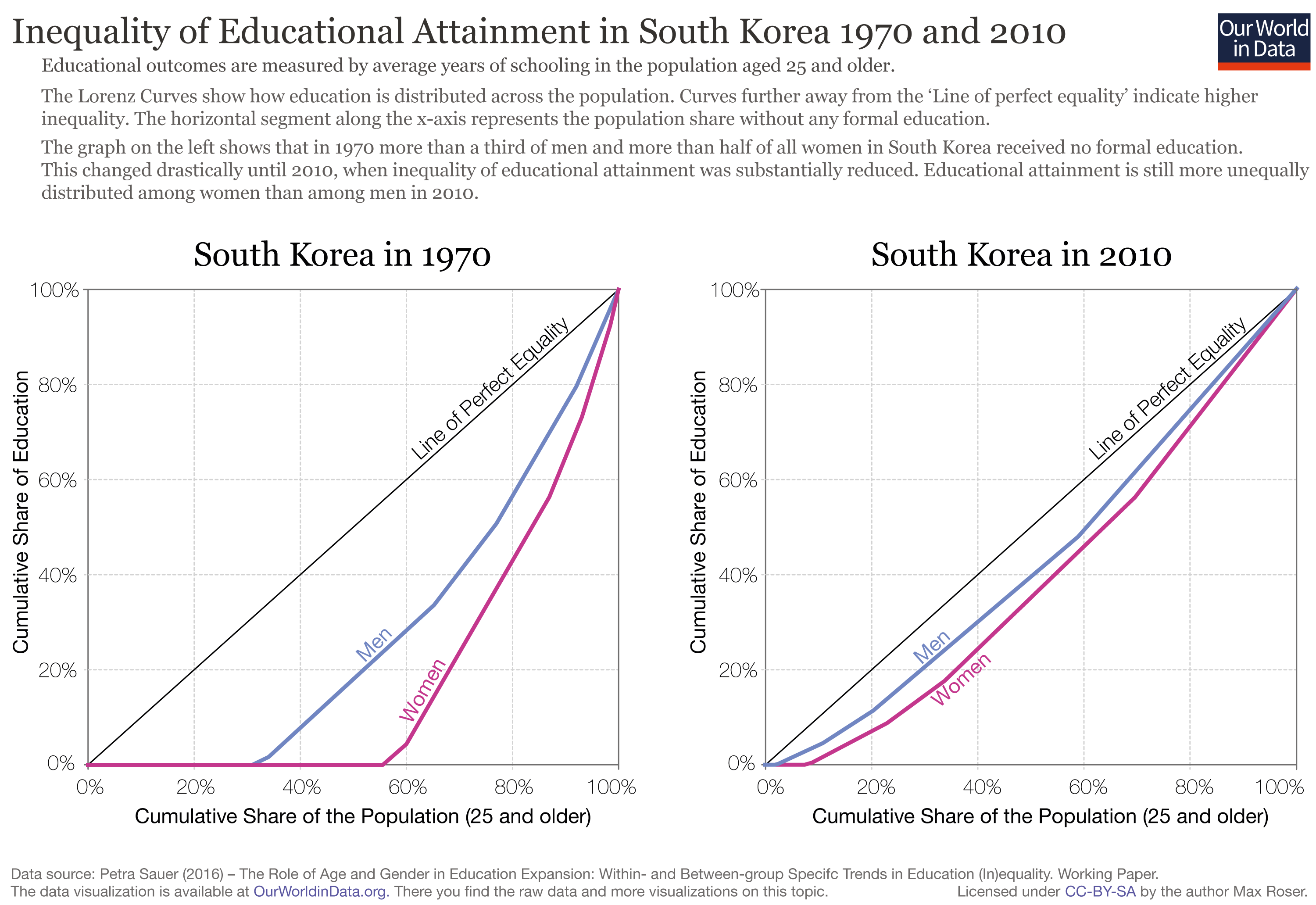
The last two decades have not a clear trend in the share of income that countries devote to education.
The following chart plots trends in public expenditure on education as a share of GDP. We can see an upward trend in some countries, but a downward trend in others.
However, as incomes – measured by GDP per capita – are generally increasing around the world, this means that the total amount of global resources spent on education is increasing in absolute terms.
The following visualization shows government expenditure on education as a share of total government expenditure. The available data also does not suggest a discernible global pattern here.
The data does suggest, however, that there is large and persistent cross-country heterogeneity in the relative importance of education vis-a-vis other sectors, even within developing countries.
Generally speaking, countries that spend a large share of their income on education also tend to prioritize education highly within their budgets.
The following visualization presents a snapshot of government spending on education around the world. Specifically, this graph plots government expenditure on education as a share of GDP on the horizontal axis, and government expenditure on education as a share of total government expenditure on the vertical axis.
As we can see, there is a positive correlation, but regional differences are stark: for almost every level of spending as a share of GDP along the horizontal axis, countries in Europe spend a smaller budget share on education.
In comparison to countries where education started expanding later, European countries tend to assign relatively more of their government education budgets to the secondary and tertiary levels, while at the same time devoting relatively less of their general government budgets to education as a whole.
This can be appreciated in the following visualization, where the prioritization of primary education (i.e. the share of primary education within the education budget) is plotted against the overall prioritization of education (i.e. the share of education within the entire government budget).
It can be seen that European countries are mostly located in the upper left. There is a weak positive correlation between the variables, both across all countries and across European countries.
The following visualization shows the percentage of total education expenditures contributed directly by households in 15 high-income countries and 15 low or middle-income countries.
The top chart in this figure, corresponding to high-income countries, shows a very clear pattern: households contribute the largest share of expenses in tertiary education, and the smallest share in primary education. Roughly speaking, this pattern tends to be progressive, since students from wealthier households are more likely to attend tertiary education, and those individuals who attend tertiary education are likely to perceive large private benefits. 13
In contrast, the bottom chart shows a very different picture: in several low-income countries households contribute proportionally more to primary education than to higher levels. Such distribution of private household contributions to education is regressive.
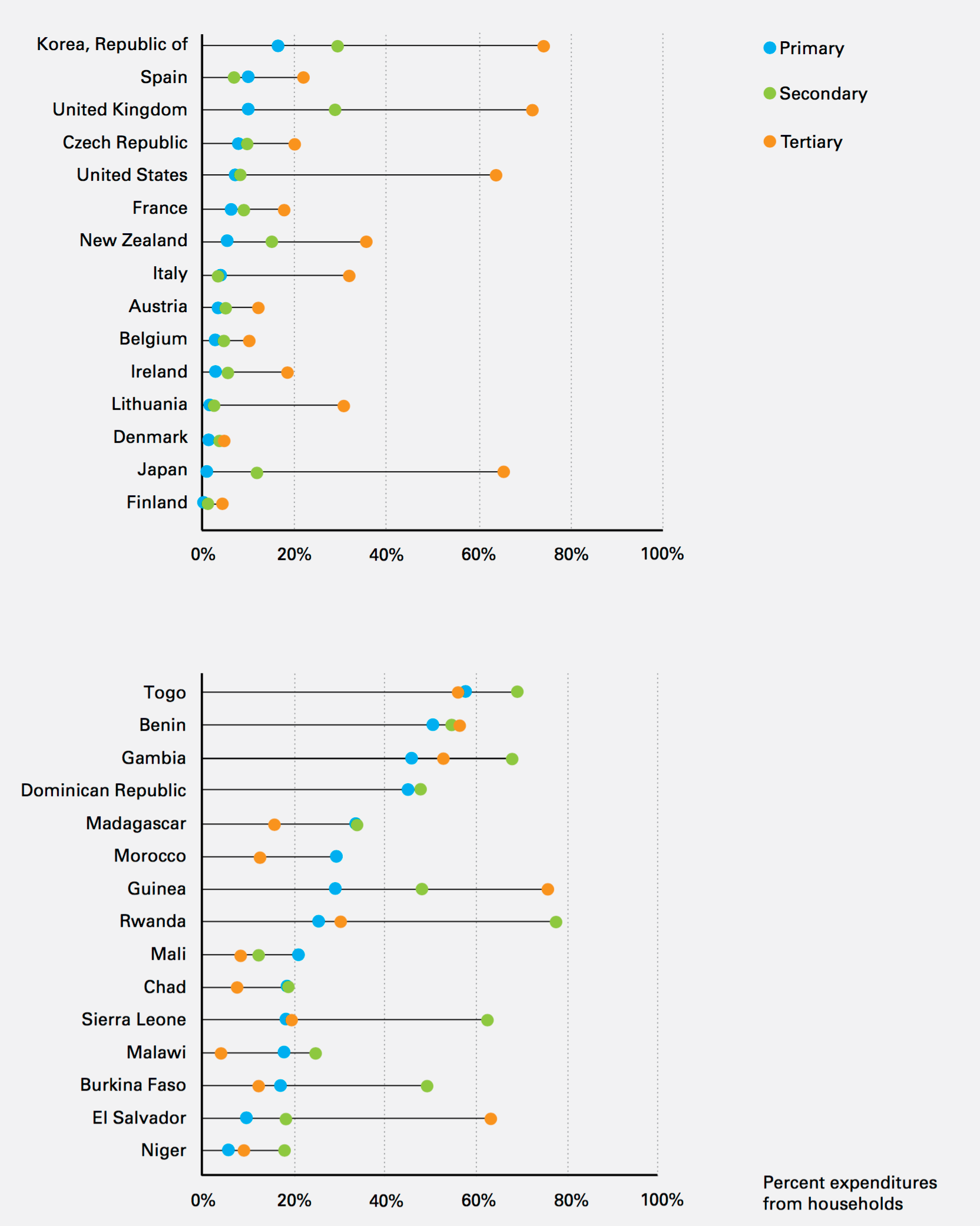
We have already mentioned that those countries that pioneered the expansion of primary education in the 19th century – all of which are current OECD member states – relied heavily on public funding to do so. Today, public resources still dominate funding for the primary, secondary, and post-secondary non-tertiary education levels in these countries.
The visualization presents OECD-average expenditure on education institutions by source of funds. 14
High-income countries tend to have better-developed pre-primary education systems than lower-income countries. However, within high-income countries, there is substantial heterogeneity in the extent to which pre-primary education is publicly financed.
The visualization presents expenditure on pre-primary educational institutions as a share of GDP across the OECD.
As can be seen, publicly funded pre-primary education tends to be more strongly developed in Europe than in the non-European countries of the OECD.
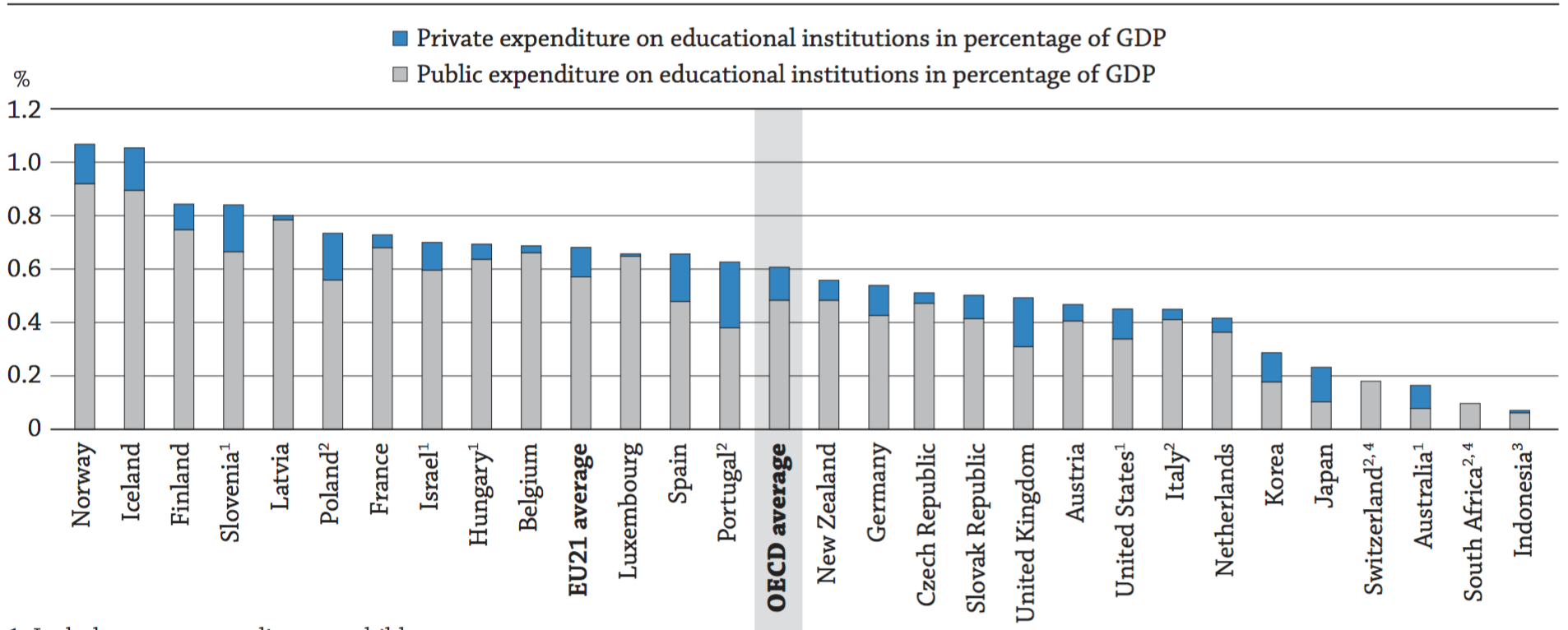
The largest part of funding devoted to education in OECD countries goes to finance current expenditures, mainly compensation of staff – specifically, teachers. The following two charts, taken from the OECD's report Education at a Glance (2015) , highlight the labor-intensive nature of education. In the lower levels of education (i.e. primary, secondary, and post-secondary non-tertiary) the share of current expenditure is very large and exhibits little cross-country variation – between 90 and 97 percent of total expenditure corresponds to current expenditure across all of the OECD countries. In higher levels of education (i.e. tertiary) there is more cross-country variation, but current expenditure still dominates by a large margin across all countries.
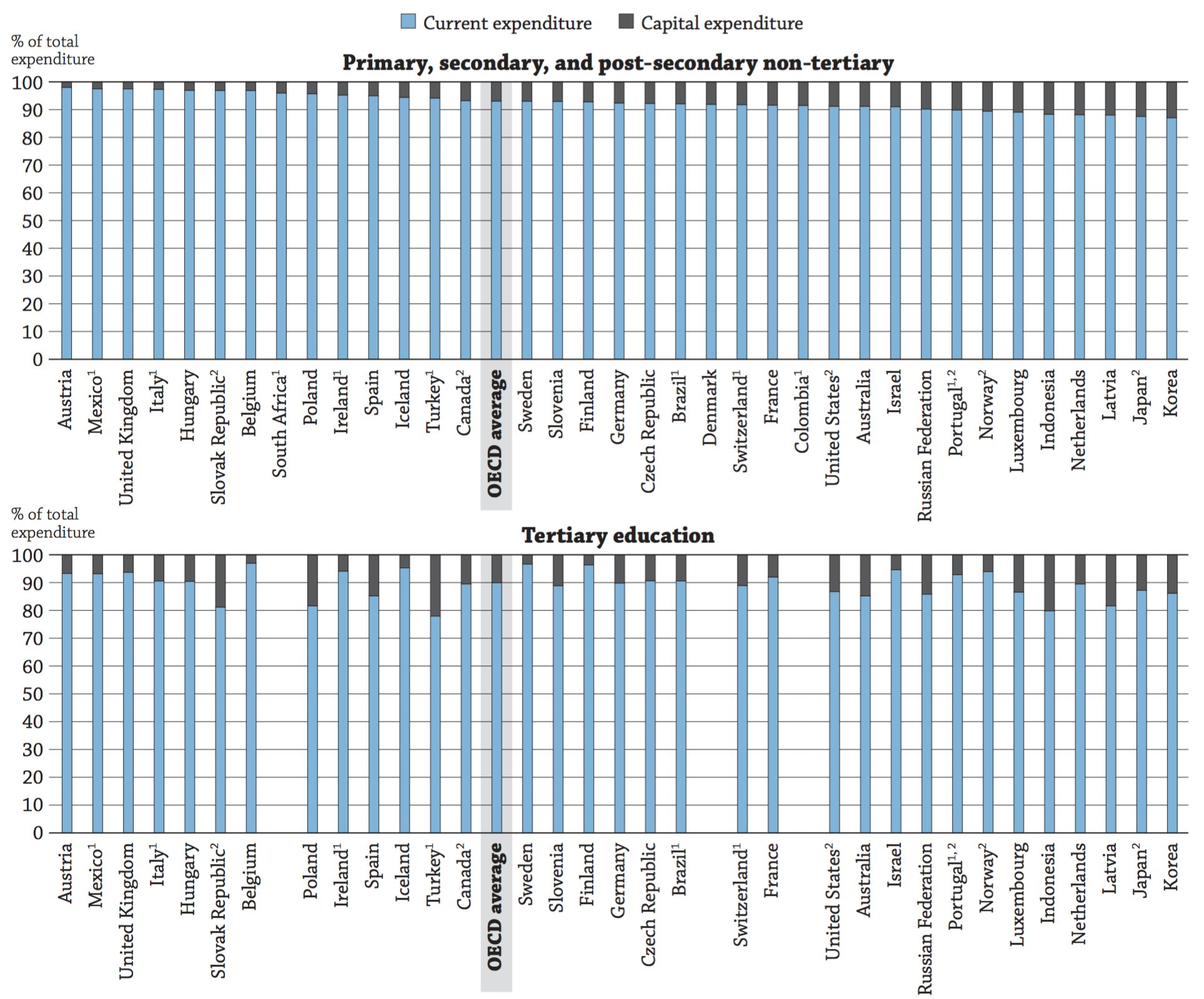
In the figures above we noted the importance of current expenditure in the production of education. The following table provides further details regarding the type of expenditures that comprise current spending. Specifically, this chart shows a breakdown of expenditure for tertiary-level institutions in the US (public and private), during the period 1980-1997. It shows that instruction accounts for almost half of expenditure; and while there are some small differences across sectors, there is a fair amount of stability in expenditures across time. This serves as a benchmark for lower education levels, where instruction takes an even larger share of expenditure. 15
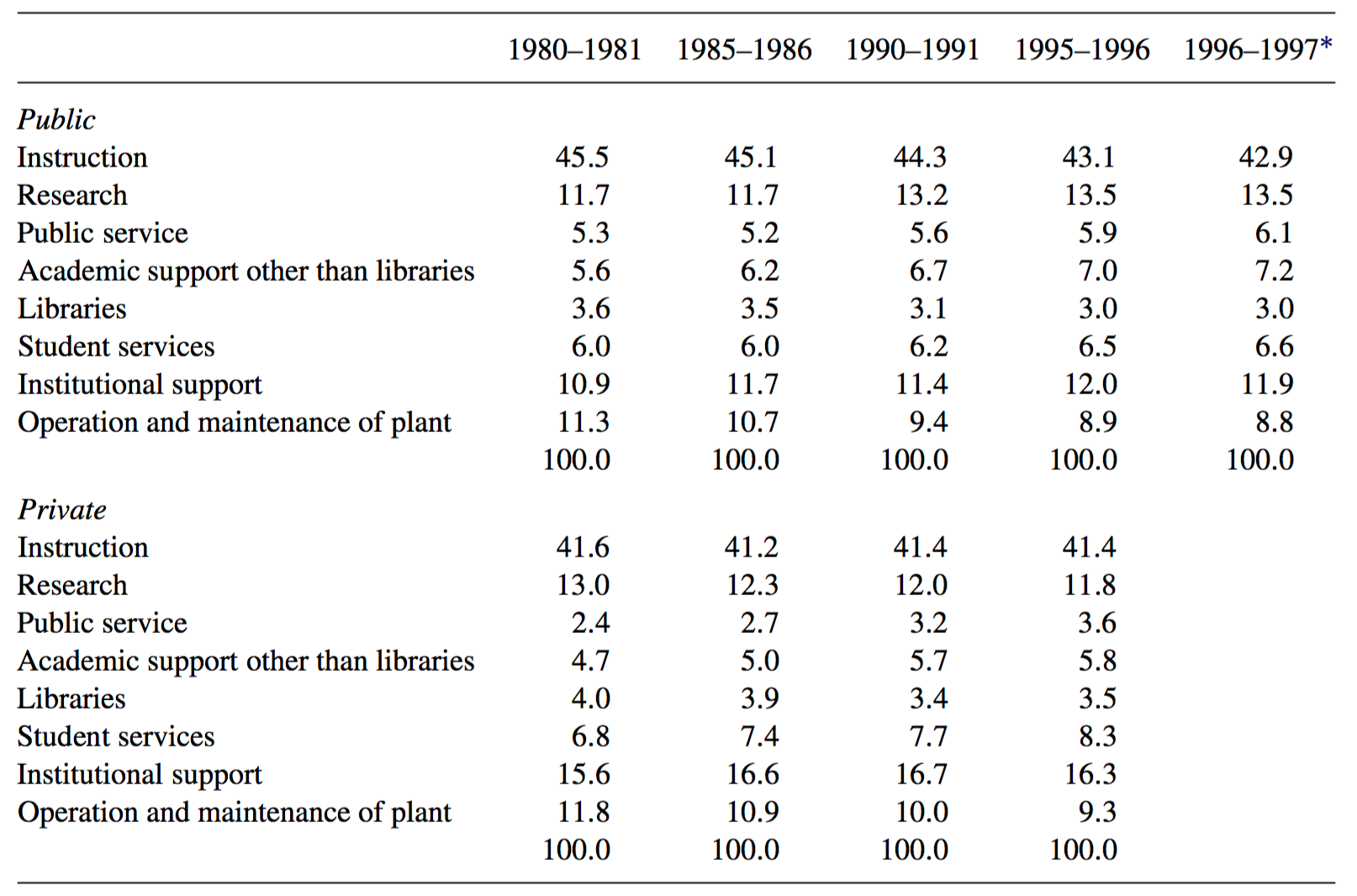
Following the agreement of the Millennium Development Goals, the first decade of the 21st century saw an important increase in international financial flows under the umbrella of development assistance (often also called development aid, or simply 'aid').
The following chart shows total OECD development assistance flows for education by level, in constant 2013 US dollars, for the period 2002-2013. As it can be seen, there are two distinct periods: in 2003-2010 flows for education increased substantially, more than doubling in real terms across all levels of education; and in the years 2010-2013 funding for basic education decreased , while funding for secondary and post-secondary education remained relatively constant. For many low-income countries, where development assistance contributes a substantial share of funding for education, this marked change in trends is important. As a reference, in 2012 development assistance accounted for more than 20 percent of all domestic spending on basic education in recipient low-income countries. 17
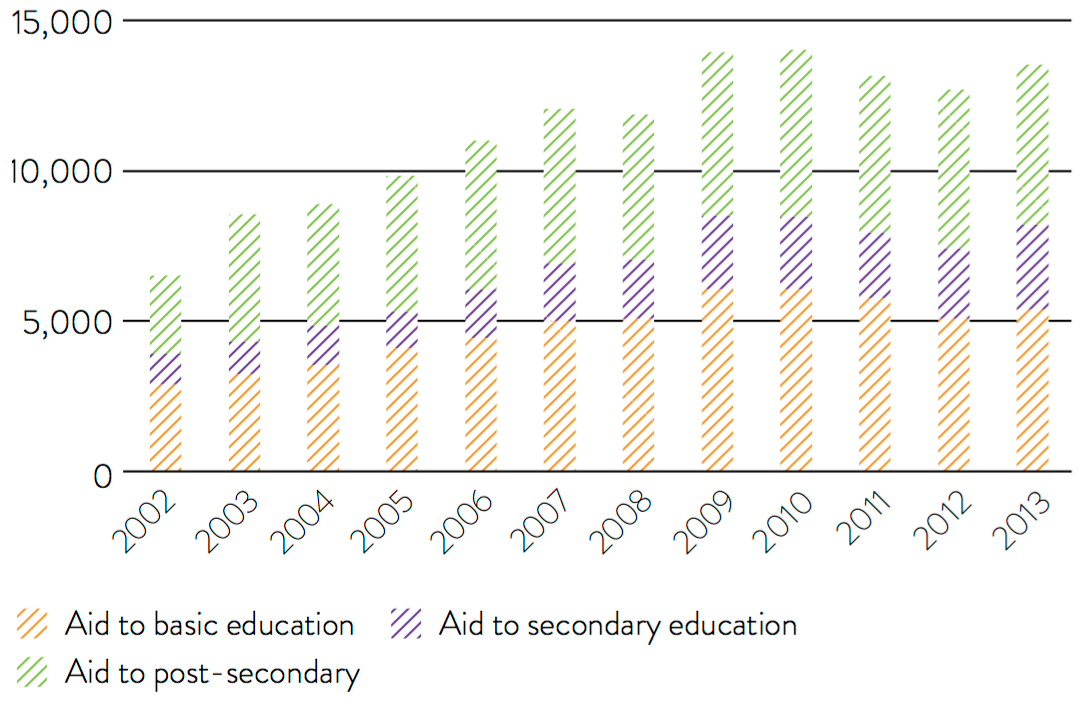
The reductions in development assistance funds for primary education have been coupled with important changes in regional priorities. Specifically, the share of development assistance for primary education going to sub-Saharan Africa has been decreasing sharply since the agreement of the Millennium Development Goals.
The following chart shows this: sub-Saharan Africa’s share in total aid to primary education declined from 52 percent in 2002 to 30 percent in 2013, while the continent’s share in the total number of out-of-school children rose from 46 percent to 57 percent.
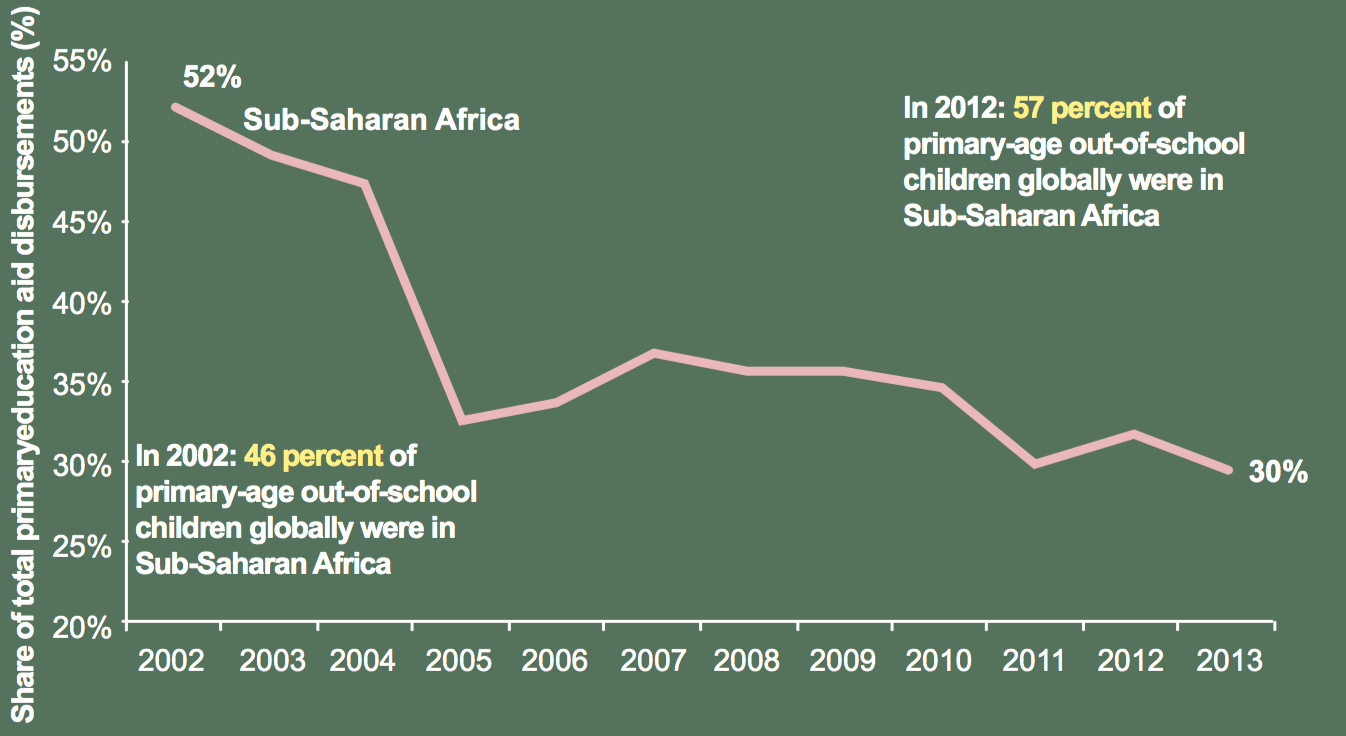
This pattern is something specific to the education sector within the broader development assistance landscape: in the healthcare sector, the overall slowdown of flows started a couple of years later, was less abrupt, and affected proportionally less the sub-Saharan countries. 18
Indeed, recent studies further highlight that development assistance for education is significantly different from assistance for healthcare in other ways: the education sector attracts less earmarked funding through multilaterals, and includes a smaller proportion of resources that developing governments can directly control for programming. 19
You can read more about development assistance for healthcare in our article on healthcare spending .
We mentioned above that public spending on education has translated, in the long run, into lower inequality in education outcomes across most of the world. But for any given country, with a given income distribution and demographic structure, the extent to which public spending on education contributes to reducing inequality depends crucially on the way in which spending is focused across education levels.
The recent UNICEF report The Investment Case for Education and Equity shows that in low-income countries, on average 46 percent of public resources are allocated to the 10 percent of students who are most educated – while this figure goes down to 26 and 13 percent in lower-middle and upper-middle income countries respectively.
The following visualization shows further details on the concentration of public spending across different countries. The vertical axis shows the percentage of public education resources going to the 10% most educated or 10% least educated students – as we can see expenditure is heavily concentrated at the top in many low-income countries.
The earlier remarks about trends in international education financing flows (namely that aid is very important in low-income countries, and that a relatively low and shrinking share of aid is going to primary levels), suggest that inequality in public spending may worsen in low-income countries. Yet development assistance priorities have the ability to change this. 20
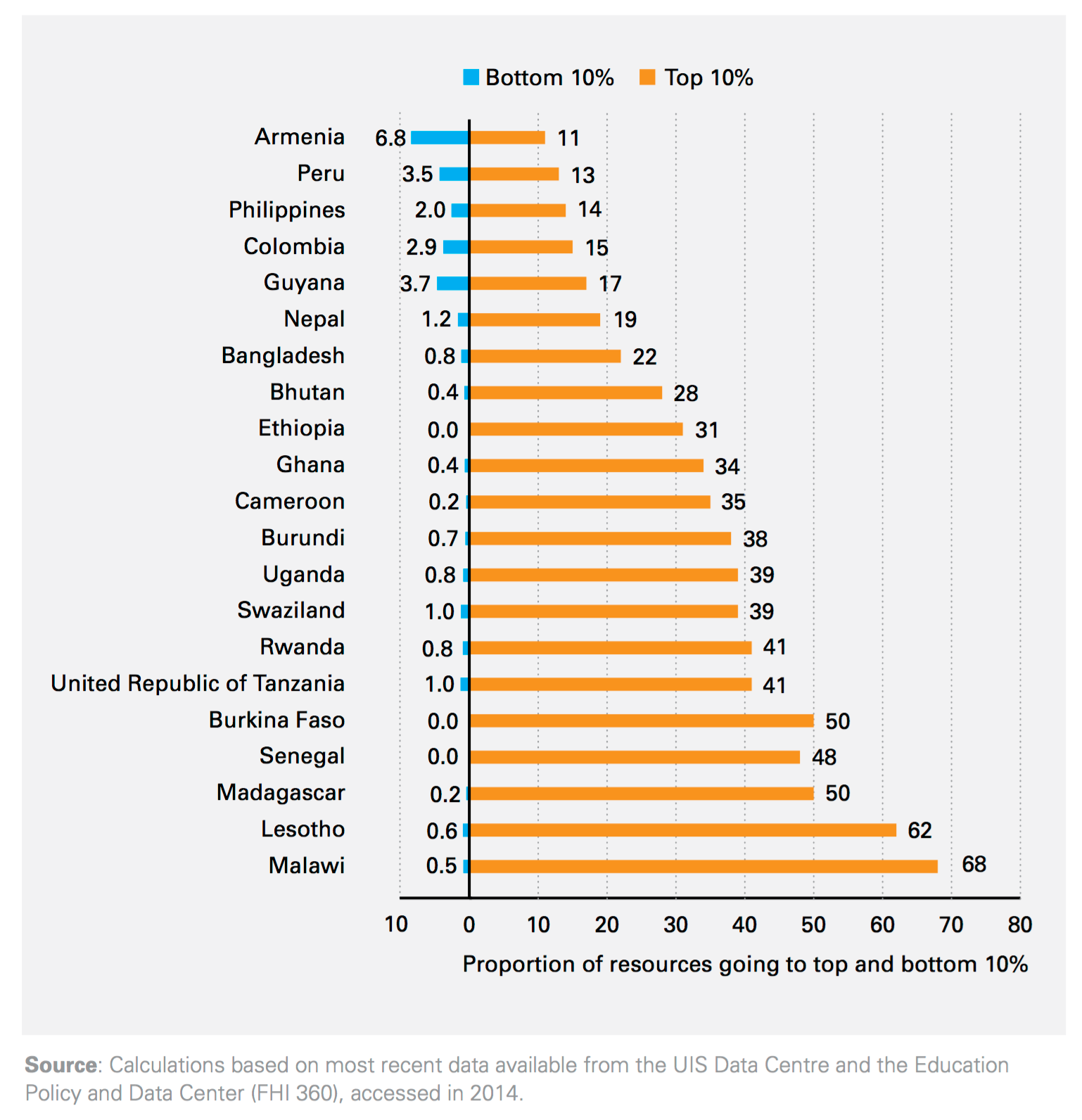
One of the reasons to justify government intervention in the market for education, is that education generates positive externalities. 21 This essentially means that investing in education yields both private and social returns. Private returns to education include higher wages and better employment prospects. Social returns include pro-social behavior (e.g. volunteering, political participation) and interpersonal trust .
The following chart uses OECD results from the Survey of Adult Skills to show how self-reported trust in others correlates with educational attainment. More precisely, this chart plots the percentage-point difference in the likelihood of reporting to trust others, by education level of respondents. Those individuals with upper secondary or post-secondary non-tertiary education are taken as the reference group, so the percentage point difference is expressed in relation to this group.
As we can see, in all countries those individuals with tertiary education were by far the group most likely to report trusting others. And in almost every country, those with post-secondary non-tertiary education were more likely to trust others than those with primary or lower secondary education. The OECD's report Education at a Glance (2015) provides similar descriptive evidence for other social outcomes.
The conclusion is that adults with higher qualifications are more likely to report desirable social outcomes, including good or excellent health, participation in volunteer activities, interpersonal trust, and political efficacy. These results hold after controlling for literacy, gender, age, and monthly earnings.
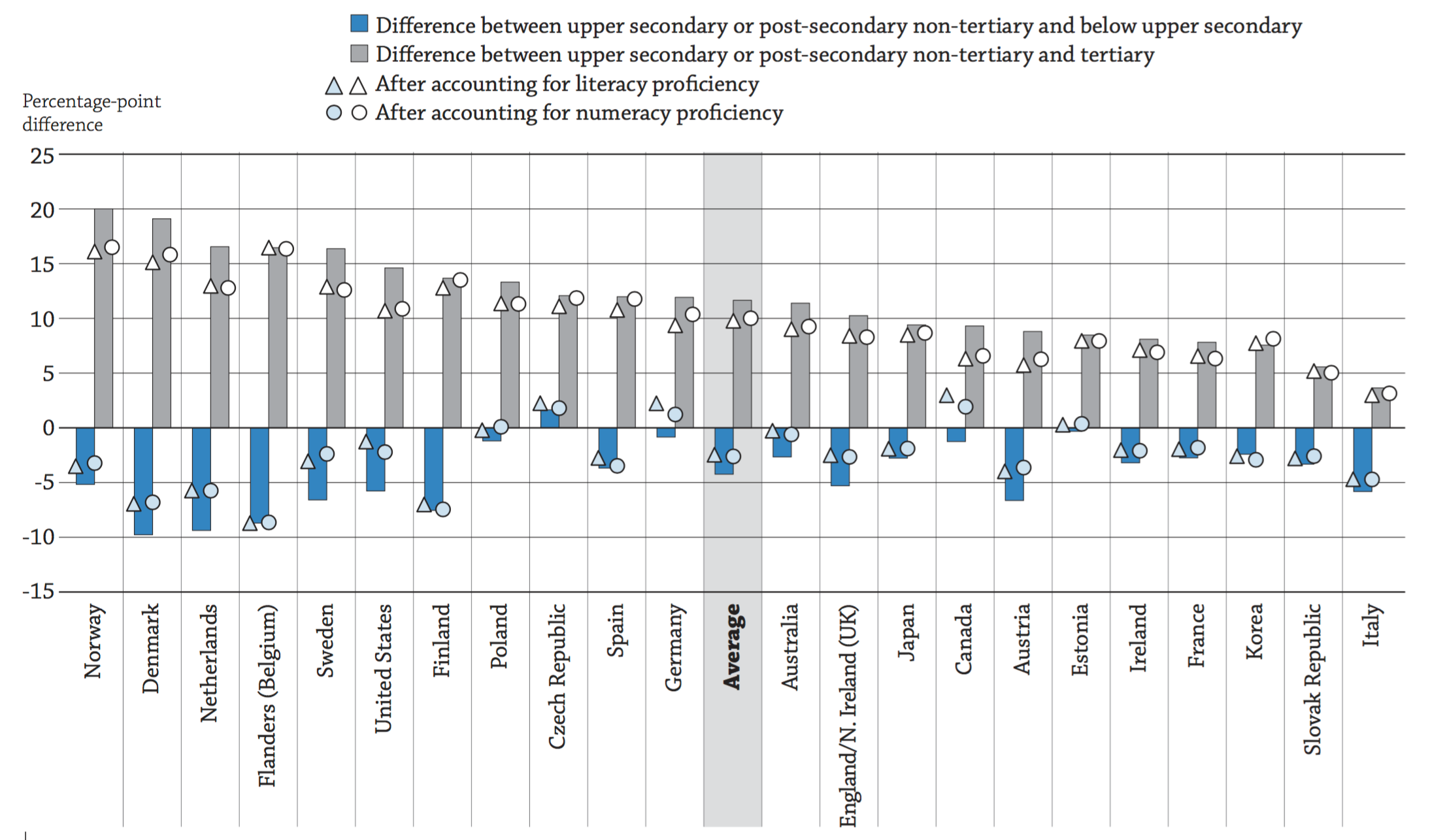
Education outcomes are typically measured via 'quantity' output (e.g. years of schooling) and 'quality' output (e.g. learning outcomes, such as test scores from the Programme for International Student Assessment – PISA).
The following visualization presents three scatter plots using 2010 data to show the cross-country correlation between (i) education expenditure (as a share of GDP), (ii) mean years of schooling, and (iii) mean PISA test scores.
At a cross-sectional level, expenditure on education correlates positively with both quantity and quality measures; and not surprisingly, the quality and quantity measures also correlate positively with each other.
But obviously correlation does not imply causation: there are many factors that simultaneously affect education spending and outcomes. Indeed, these scatterplots show that despite the broad positive correlation, there is substantial dispersion away from the trend line – in other words, there is substantial variation in outcomes that does not seem to be captured by differences in expenditure.
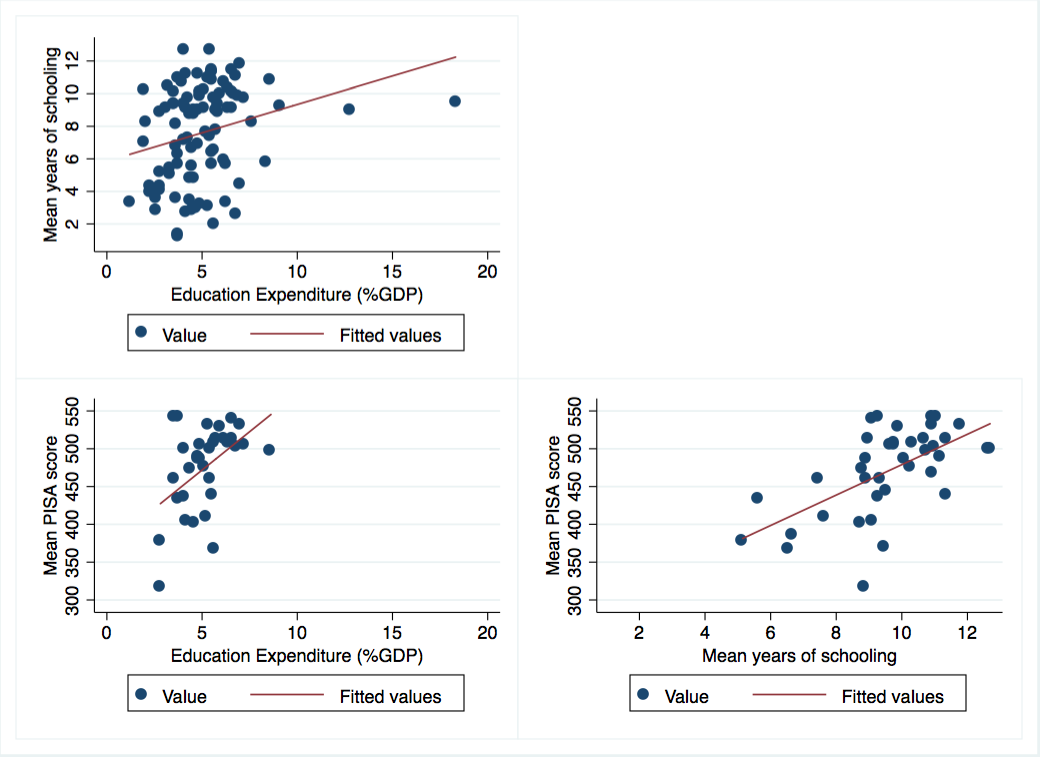
The following visualization presents the relationship between PISA reading outcomes and average education spending per student, splitting the sample of countries by income levels.
It shows that income is an important factor that affects both expenditure on education and education outcomes: we can see that above a certain national income level, the relationship between PISA scores and education expenditure per pupil becomes virtually nonexistent.
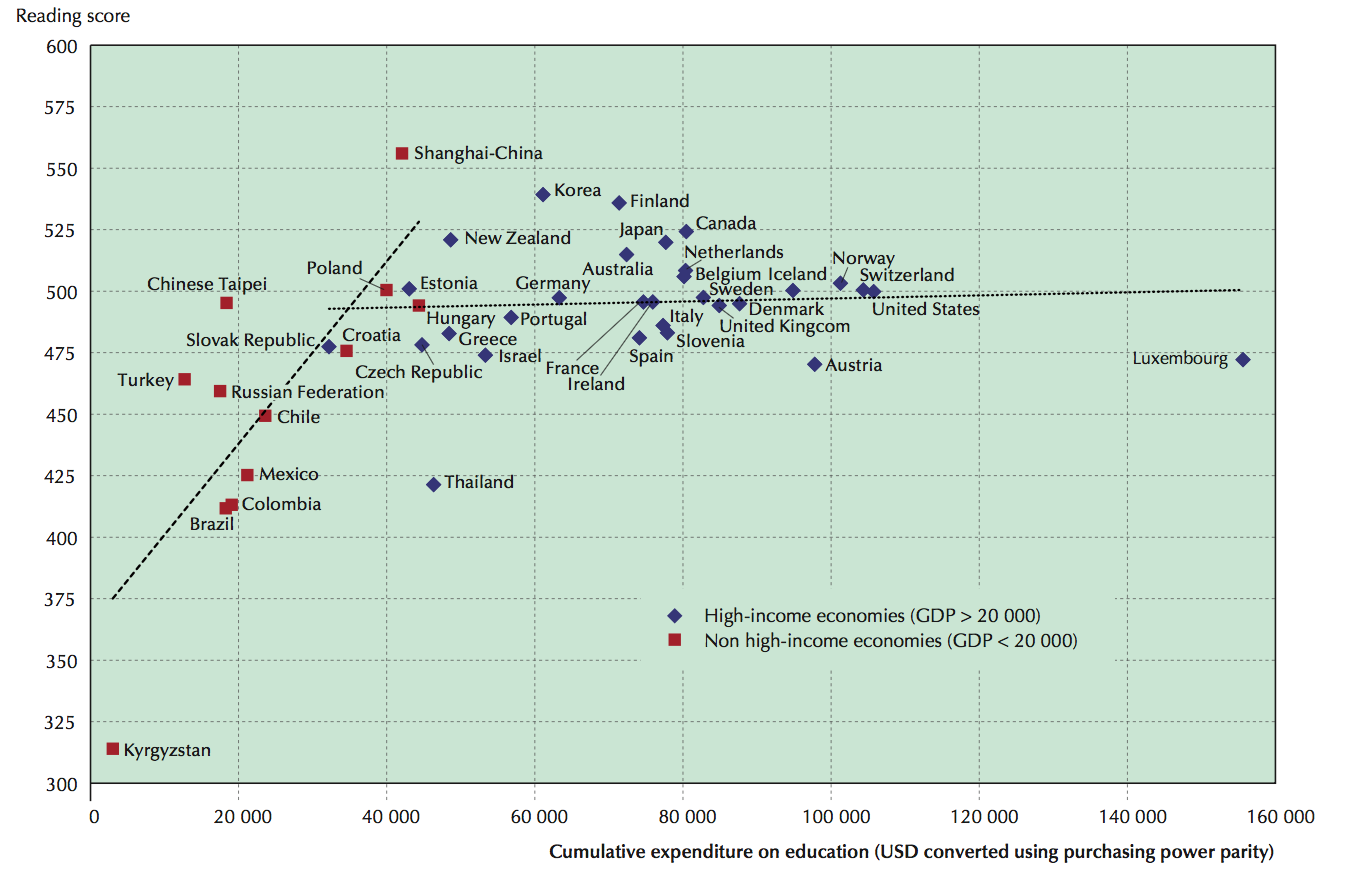
Several studies with more sophisticated econometric models corroborate the fact that expenditure on education does not explain well cross-country differences in learning outcomes. 25
A vast number of studies have tried to estimate the impact of classroom resources on learning outcomes.
The following table summarizes results from the systematic review in Hanushek (2006). 26 In this table, the left-hand side summarizes results from econometric studies focusing on developing countries, while the right-hand side presents evidence from the US (where studies have concentrated extensively).
We can see that for all listed inputs and across all countries, the share of studies that have found a positive effect is small – in fact, the majority of studies find either no effect or a negative effect. This clearly does not mean that these classroom resources are not important, but rather that it is very difficult to know with confidence when and where they are a binding constraint to improve learning outcomes.
A first conclusion, therefore, seems to be that context and input mix are fundamental to improving outcomes – even in developing countries where the expected returns to additional resources is large across the board.
Taking the ratio of positive to negative effects detected in the literature as a proxy for what tends to work best, we can derive a second conclusion from the table: spending more resources on better teachers (i.e. improving teacher experience and teacher education) tends to work better to improve learning outcomes than simply increasing the number of teachers per pupil. This seems to be true both in developed and developing countries.
This last conclusion is consistent with the main message from the OECD's report Does money buy strong performance in PISA? , which points out that countries that prioritized the quality of teachers over class sizes performed better in PISA tests. 27
This is is also consistent with a recent high-quality study on the impact of teacher quality on test scores using data from the US, which suggests that improvements in teacher quality can causally raise students’ test scores. 28

Education in low-income countries is particularly difficult because there is substantial heterogeneity in the degree of preparation that children have when they enter school – much more so than in high-income countries.
Evidence from policy 'experiments' in developing countries suggests remedial teaching, in the form of assistants teaching targeted lessons to the bottom of the class, can yield substantial improvements in learning outcomes.
The following visualization summarizes the effects of four different policy treatments within the so-called Teacher Community Assistant Initiative (TCAI) in Ghana – this is an initiative that evaluated four different such remedial teaching interventions. 30
The units in this figure are standard deviations of test results. The first two sets of estimates correspond to the test-score impacts of enabling community assistants to provide remedial instruction specifically to low-performing children, either during school or after school. The third set of estimates corresponds to test-score impacts of providing a community assistant and reducing class size, without targeting instruction to low-performing pupils. The last set of results corresponds to testing the effect of training teachers to provide small-group instruction targeted at pupils’ actual learning levels.
As we can see, while all interventions had a positive effect, the lowest impacts – across all tests – come from the non-targeted 'normal curriculum' intervention that reduced class sizes, and from the intervention that provided training to teachers on how to engage in targeted remedial teaching themselves. This suggests that the improvements in outcomes were caused by the combination of targeted instruction and TCAs who, unlike teachers, were specifically dedicated to this purpose. These results are consistent with findings from across Africa, suggesting that teaching at the right level causes better learning outcomes in a cost-effective way. 31
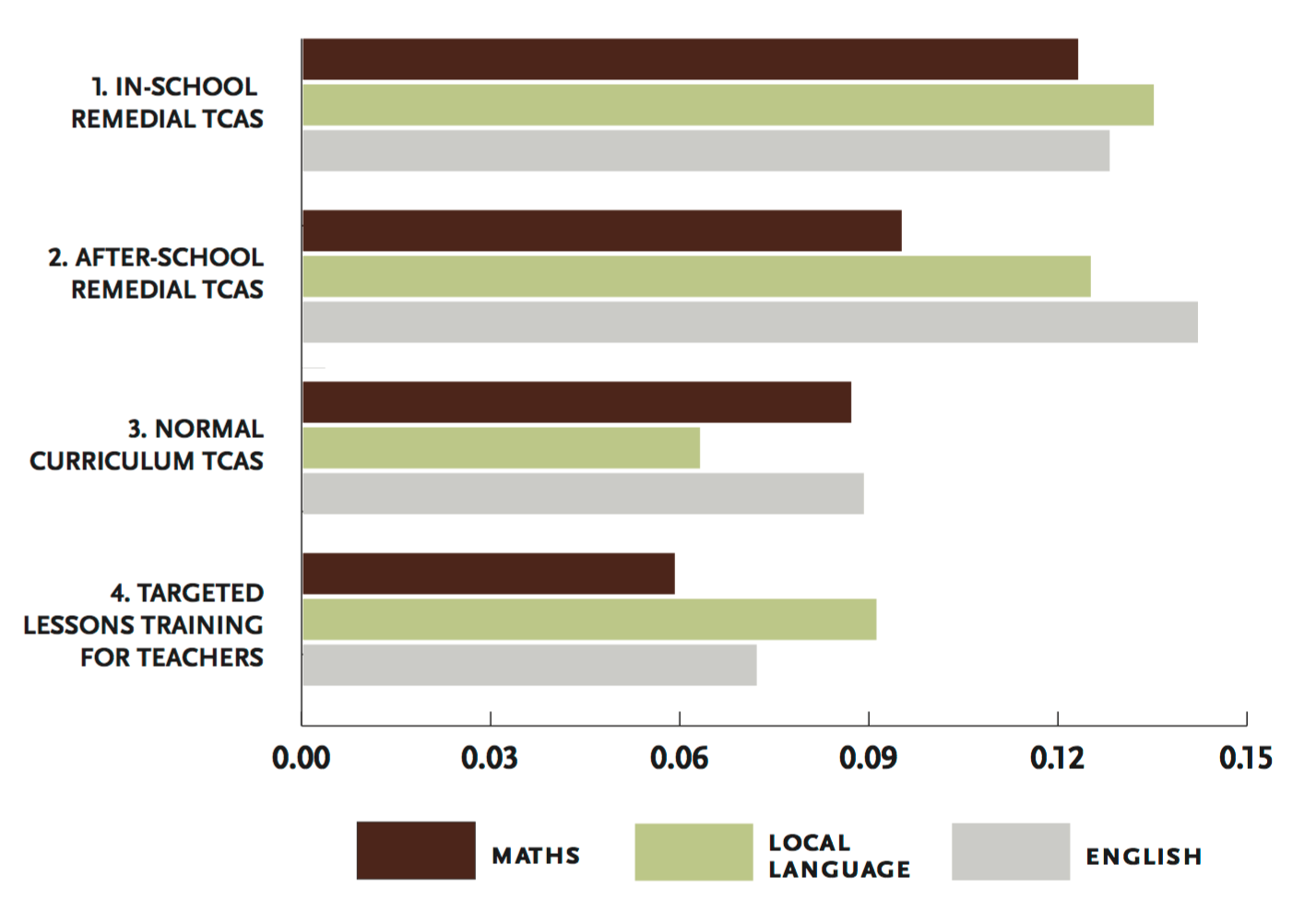
We have already made the point that the bulk of education expenditure goes specifically towards financing teachers. We have also pointed out that improving teacher quality may be a particularly good instrument to improve teaching outcomes. This leads to a natural question: are pay-for-performance teacher contracts an effective instrument to improve learning outcomes? A growing body of literature in the economics of education has started using randomized control trials (i.e. policy 'experiments') to answer this question. Glewwe and Muralidharan (2016) provide the following account of the available evidence:
"Results suggest that even modest changes to compensation structures to reward teachers on the basis of objective measures of performance (such as attendance or increases in student test scores) can generate substantial improvements in learning outcomes at a fraction of the cost of a "business as usual" expansion in education spending. However, not all performance pay programs are likely to be effective, so it is quite important to design the bonus formulae well and to make sure that these designs reflect insights from economic theory." 33
The conclusion is that well-designed pay-for-performance contracts are a cost-effective instrument to boost test scores; but this does not mean that they are necessarily effective at achieving other – perhaps equally important – objectives of time spent in school. In simple words, it is possible that pay-for-performance yields 'teaching to the test'.
Other incentive mechanisms, such as community-based monitoring of teachers, have been proposed as an alternative. Glewwe and Muralidharan (2016) also provide a review of the – somewhat limited – available evidence on such alternative incentive mechanisms. 34
Demand-side inputs are as important as supply-side inputs to produce education. Attending school and exerting effort are perhaps the most obvious examples: without these inputs, even the best-endowed schools will fail to deliver good outcomes.
The table summarizes information on different demand-side investments that have been shown to successfully improve quality and quantity outcomes. More precisely, this table gathers evidence from randomized control trials in developing countries, as per the review in Glewwe and Muralidharan (2016). The reported figures correspond to positive/negative significant/insignificant estimates across a set of available experimental studies (bear in mind some studies estimate more than one effect – e.g. by measuring outcomes at several points in time).
As we can see, the evidence suggests interventions that increase the benefits of attending school – such as conditional cash transfers – are likely to increase student time in school. And those that increase the benefits of higher effort and better academic performance – such as merit scholarships – are likely to improve learning outcomes. 35 .
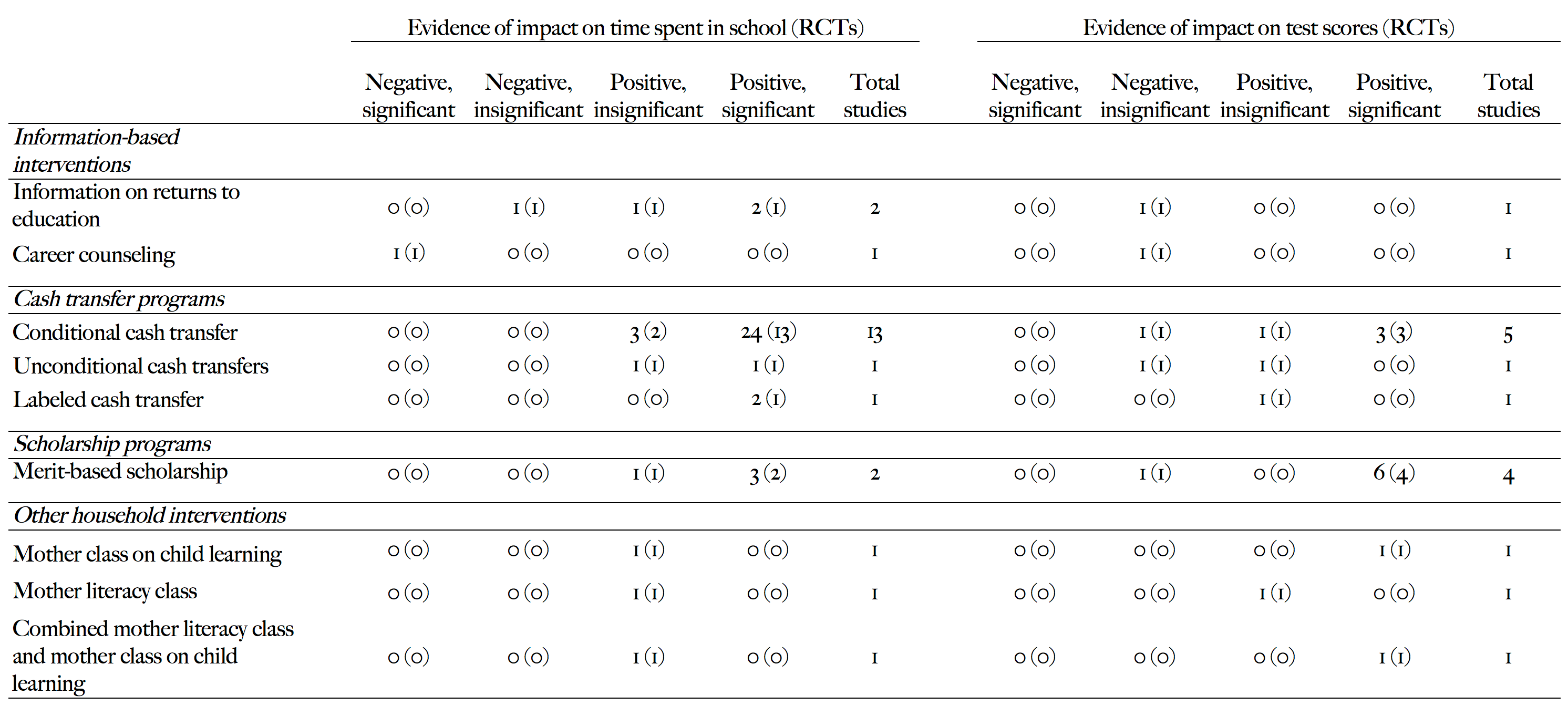
In many low-income countries, health problems are an important factor preventing children from attending school.
The following visualization presents a comparison of the impact that a number of different health interventions have achieved in different countries – together with some non-health-related interventions that serve as references. The height of each bar in this graph reflects the additional school years achieved per hundred dollars spent on the corresponding intervention; so these estimates can be interpreted as a measure of how cost-effective the different interventions are. 37
We see that treating children for intestinal worms (labeled 'deworming' in the chart) led to an additional 13.9 years of education for every $100 spent in Kenya; while a program targeting anemia (labeled 'iron fortification') led to 2.7 additional years per $100 in India. These interventions seem to be much more cost-effective in improving test scores than conditional cash transfers, free school uniforms, or merit scholarships. 38
Of course, ranking these interventions is not trivial since most programs achieve multiple outcomes – indeed, we have already discussed that remedial teaching is generally effective to increase test-scores, although here we see a particular instance where it had no impact on school attendance.
Nevertheless, health interventions seem to be particularly interesting, since they lead to substantial achievements in both education and health outcomes. 39
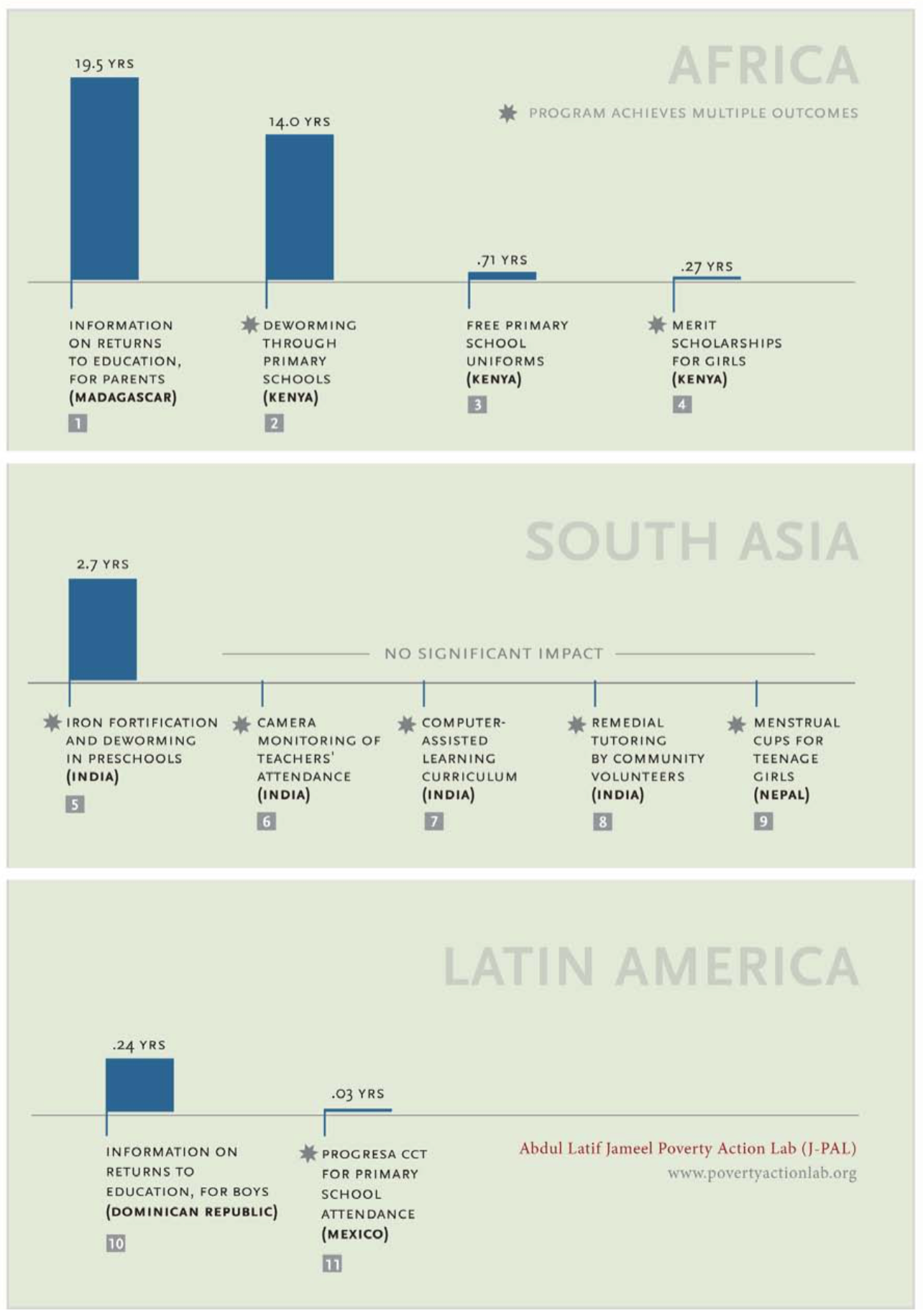
The environment that children are exposed to early in life plays a crucial role in shaping their abilities, behavior, and talents. To a great extent, this is what drives large and remarkably persistent gaps in education achievement between individuals in the same country, but in different socioeconomic environments. Cunha et al. (2006) provide a detailed account of the theory and evidence behind this claim and discuss its implications for the design of education policies.
In the chart, we see the impacts of the Perry Preschool Program – a flagship experimental intervention study, designed to test the impact of preschool education on subsequent education outcomes. 41
The chart shows disadvantaged children participating in the preschool program (the 'treatment group') had higher grades and were more likely to graduate from high school than the reference control group. Moreover, they spent substantially less time in special education. Other programs have similarly shown evidence of very large and persistent returns to early education interventions.
